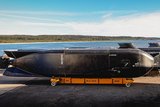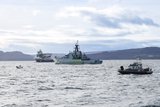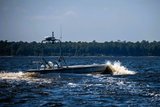Airbus and Rohde & Schwarz boost Royal Navy connectivity
The Type 26 frigate HMS Cardiff, one of the new generation of Royal Navy warships. (Photo: UK MoD/Crown Copyright)
Airbus Defence and Space and Rohde & Schwarz have signed a Memorandum of Understanding (MoU) to improve the technological connectivity offering of the UK’s Royal Navy (RN).
The aim of the collaboration is to enhance the resilience of the RN’s communication framework and systems against potential attack, compromise or straightforward signal loss. That involves upgrading the technology on board the RN’s warships.
Airbus’ Maritime Network Evolution (MNE) product will be the bedrock of the improvement, with Rohde & Schwartz adding in its own communications technology. The collaboration has the goal of maintaining continuous and secure connectivity, even in particularly hostile signal environments, or in operational scenarios when enemy vessels might actively attempt to block out Royal Navy communications. This kind of signal warfare is being used increasingly to isolate, confuse or disconnect vessels from the chain of command.
Related Articles
SEA to trial sonar software for UK Royal Navy
UK SMEs bid for Royal Navy warship work under new agreement
Airbus’ MNE is a Beyond Line Of Sight (BLOS) IP-based communication architecture already in place within the Royal Navy surface fleet of 20 warships. That includes in-service Type 23 and Type 45 vessels. It will also be on board the newer Type 26 and Type 31e vessels.
The idea behind such coverage is that, along with Airbus’ SCOT Mission Military X-band terminal and Skynet constellation, the MNE creates what the Airbus calls a “true network of the sea”.
Rohde & Schwartz is best known for its NAVICS voice communication system within the ecosystem of a vessel and its SOVERON system for ship-to-ship communications with what it calls “digital sovereignty”.
The new collaboration, however, is likely to create a range of Royal Navy-specific communications solutions.
Gary Mackay, managing director at Rohde & Schwarz UK Ltd, said: “We look forward to contributing to the development of innovative solutions that meet the evolving requirements of the Royal Navy.”
The development of collaborative Royal Navy communications systems is ongoing as of September 2024. The UK government has widely publicised a £22 billion (US$28.7 billion) hole in the country’s finances, and defence secretary John Healey has confirmed that the Ministry of Defence will play its part in helping plug that gap.
Whether there will be naval programmes that are shelved or scrapped will depend on the contents of UK chancellor Rachel Reeves’ first budget in October 2024.
Related Programmes in Defence Insight
Global Combat Ship Programme - Batch 2 - City Class (Type 26)
More from Naval Warfare
-
![Canadian Coast Guard’s OOSV delivery is “major milestone” in fleet modernisation]()
Canadian Coast Guard’s OOSV delivery is “major milestone” in fleet modernisation
The Polar Class 6 platform is the largest CCG science-dedicated vessel and will operate on the country’s east coast.
-
![How the Anduril-HHI autonomous ship plan fits in with the US Navy’s MASC programme]()
How the Anduril-HHI autonomous ship plan fits in with the US Navy’s MASC programme
The new modular vessel is expected to be developed for both commercial and defence use, with a heavy focus on production speed and mission flexibility.
-
![Indo Pacific 2025: Autonomous systems reigned but can the Australian Defence Force afford it?]()
Indo Pacific 2025: Autonomous systems reigned but can the Australian Defence Force afford it?
Multiple autonomous systems and technologies were on display at this year’s Indo Pacific, but questions remain over how the Australian Department of Defence will balance the books.
-
![How the UK Royal Navy is powering up its hybrid fleet to combat new threats]()
How the UK Royal Navy is powering up its hybrid fleet to combat new threats
Since it announced its move towards a new “hybrid navy” earlier this year, the force has announced a number of new uncrewed technologies in the works.
-
![US and UK to begin Trident II D5 Increment 8 in October 2026]()
US and UK to begin Trident II D5 Increment 8 in October 2026
Trident II D5 Increment 8 will involve improvements to the shipboard navigation subsystem for the US Ohio and Columbia and the UK Dreadnought and Vanguard submarine classes.
-
![US Navy starts acquisition process for uncrewed maritime systems for support missions]()
US Navy starts acquisition process for uncrewed maritime systems for support missions
The USN is interested in uncrewed capabilities that can carry out explosive ordnance disposal, mine countermeasures, force protection, ISR and anti-submarine missions.























